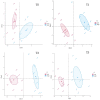Efficacy of Transcranial Direct Current Stimulation (tDCS) on Balance and Gait in Multiple Sclerosis Patients: A Machine Learning Approach
- PMID: 35743575
- PMCID: PMC9224780
- DOI: 10.3390/jcm11123505
Efficacy of Transcranial Direct Current Stimulation (tDCS) on Balance and Gait in Multiple Sclerosis Patients: A Machine Learning Approach
Abstract
Transcranial direct current stimulation (tDCS) has emerged as an appealing rehabilitative approach to improve brain function, with promising data on gait and balance in people with multiple sclerosis (MS). However, single variable weights have not yet been adequately assessed. Hence, the aim of this pilot randomized controlled trial was to evaluate the tDCS effects on balance and gait in patients with MS through a machine learning approach. In this pilot randomized controlled trial (RCT), we included people with relapsing−remitting MS and an Expanded Disability Status Scale >1 and <5 that were randomly allocated to two groups—a study group, undergoing a 10-session anodal motor cortex tDCS, and a control group, undergoing a sham treatment. Both groups underwent a specific balance and gait rehabilitative program. We assessed as outcome measures the Berg Balance Scale (BBS), Fall Risk Index and timed up-and-go and 6-min-walking tests at baseline (T0), the end of intervention (T1) and 4 (T2) and 6 weeks after the intervention (T3) with an inertial motion unit. At each time point, we performed a multiple factor analysis through a machine learning approach to allow the analysis of the influence of the balance and gait variables, grouping the participants based on the results. Seventeen MS patients (aged 40.6 ± 14.4 years), 9 in the study group and 8 in the sham group, were included. We reported a significant repeated measures difference between groups for distances covered (6MWT (meters), p < 0.03). At T1, we showed a significant increase in distance (m) with a mean difference (MD) of 37.0 [−59.0, 17.0] (p = 0.003), and in BBS with a MD of 2.0 [−4.0, 3.0] (p = 0.03). At T2, these improvements did not seem to be significantly maintained; however, considering the machine learning analysis, the Silhouette Index of 0.34, with a low cluster overlap trend, confirmed the possible short-term effects (T2), even at 6 weeks. Therefore, this pilot RCT showed that tDCS may provide non-sustained improvements in gait and balance in MS patients. In this scenario, machine learning could suggest evidence of prolonged beneficial effects.
Keywords: gait analysis; machine learning; mobility; multiple factor analysis; multiple sclerosis; neurorehabilitation; rehabilitation; tDCS.
Conflict of interest statement
The authors declare no conflict of interest.
Figures





Similar articles
-
Effectiveness of transcranial direct current stimulation on balance and gait in patients with multiple sclerosis: systematic review and meta-analysis of randomized clinical trials.J Neuroeng Rehabil. 2023 Oct 24;20(1):142. doi: 10.1186/s12984-023-01266-w. J Neuroeng Rehabil. 2023. PMID: 37875941 Free PMC article.
-
Short term effects of anodal cerebellar vs. anodal cerebral transcranial direct current stimulation in stroke patients, a randomized control trial.Front Neurosci. 2022 Nov 24;16:1035558. doi: 10.3389/fnins.2022.1035558. eCollection 2022. Front Neurosci. 2022. PMID: 36507323 Free PMC article.
-
Erratum.Mult Scler. 2016 Oct;22(12):NP9-NP11. doi: 10.1177/1352458515585718. Epub 2015 Jun 3. Mult Scler. 2016. PMID: 26041800
-
Robotic-assisted gait training combined with transcranial direct current stimulation in chronic stroke patients: A pilot double-blind, randomized controlled trial.Restor Neurol Neurosci. 2017;35(5):527-536. doi: 10.3233/RNN-170745. Restor Neurol Neurosci. 2017. PMID: 28800341 Clinical Trial.
-
The Effects of Transcranial Direct Current Stimulation on Balance and Gait in Stroke Patients: A Systematic Review and Meta-Analysis.Front Neurol. 2021 May 25;12:650925. doi: 10.3389/fneur.2021.650925. eCollection 2021. Front Neurol. 2021. PMID: 34113308 Free PMC article.
Cited by
-
Identifying the engagement of a brain network during a targeted tDCS-fMRI experiment using a machine learning approach.PLoS Comput Biol. 2023 Apr 12;19(4):e1011012. doi: 10.1371/journal.pcbi.1011012. eCollection 2023 Apr. PLoS Comput Biol. 2023. PMID: 37043484 Free PMC article.
-
Efficacy of interoceptive and embodied rehabilitative training protocol in patients with mild multiple sclerosis: A randomized controlled trial.Front Neurol. 2022 Dec 21;13:1095180. doi: 10.3389/fneur.2022.1095180. eCollection 2022. Front Neurol. 2022. PMID: 36619928 Free PMC article.
-
Effectiveness of transcranial direct current stimulation on balance and gait in patients with multiple sclerosis: systematic review and meta-analysis of randomized clinical trials.J Neuroeng Rehabil. 2023 Oct 24;20(1):142. doi: 10.1186/s12984-023-01266-w. J Neuroeng Rehabil. 2023. PMID: 37875941 Free PMC article.
-
Wearable Sensor Technologies to Assess Motor Functions in People With Multiple Sclerosis: Systematic Scoping Review and Perspective.J Med Internet Res. 2023 Jul 27;25:e44428. doi: 10.2196/44428. J Med Internet Res. 2023. PMID: 37498655 Free PMC article.
-
Ultrasound-Guided Injections and Proprioceptive Neuromuscular Facilitation as Shoulder Rehabilitation for Multiple Sclerosis and Neuropathic Pain.Healthcare (Basel). 2022 Sep 25;10(10):1869. doi: 10.3390/healthcare10101869. Healthcare (Basel). 2022. PMID: 36292316 Free PMC article.
References
-
- Solaro C., de Sire A., Uccelli M.M., Mueller M., Bergamaschi R., Gasperini C., Restivo D.A., Stabile M.R., Patti F. Efficacy of levetiracetam on upper limb movement in multiple sclerosis patients with cerebellar signs: A multicenter double-blind, placebo-controlled, crossover study. Eur. J. Neurol. 2020;27:2209–2216. doi: 10.1111/ene.14403. - DOI - PubMed
LinkOut - more resources
Full Text Sources

